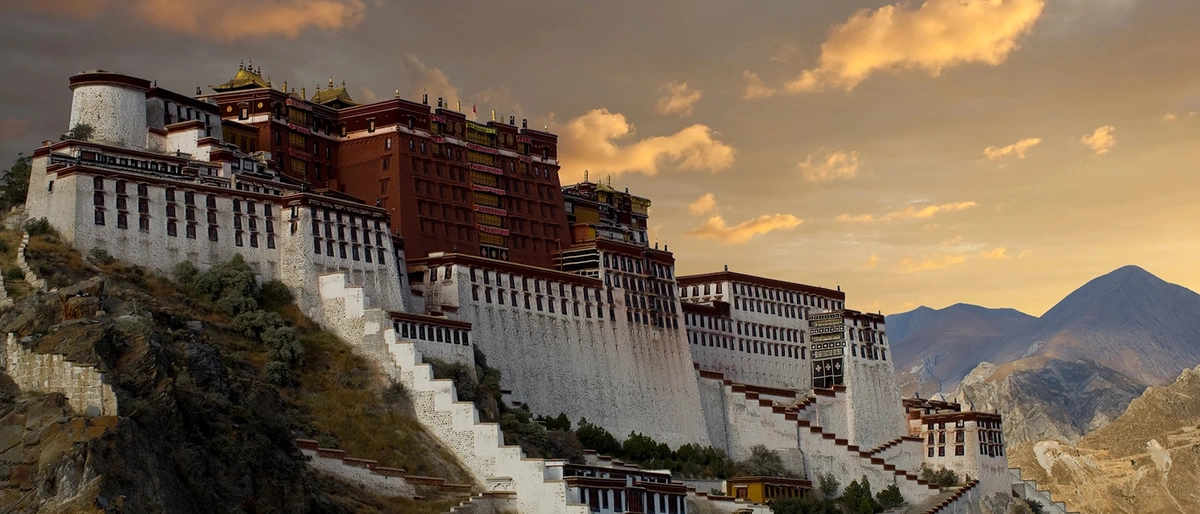Situated in the south of the Tibet Autonomous Region at an altitude of 11,975 feet, Lhasa is an impressive city steeped with a cultural and spiritual history dating back thousands of years.
Explore: Potala Palace
The surrounding landscape and terrain of Lhasa is truly spectacular with impressive mountain ranges covered in thick green fauna. The beautiful and serene Kyichu River, sometimes referred to as the Lhasa River, passes the city on the south and winds through the picturesque mountain fringed valley.
Set in the south central part of the Tibet Autonomous Region the city is extremely remote, which adds to the mysterious and romantic atmosphere. Although the city is tucked away in the high mountains of Tibet, the population of Lhasa is over 400,000 with around 180,000 living in the urban city area.
Lhasa is considered one of the most revered holy lands for Tibetan Buddhists and attracts thousands of visitors from around the world each year. Most visitors come to see the numerous temples and monasteries found throughout the city. One of the most famous attractions is Potala Palace, which has been home to kings and various Dalai Lamas since the 7th century.
Another popular attraction to visit is Jokhang Temple, located in the downtown area of the city. The beautiful and impressive temple is listed as an UNESCO World Heritage site and dates back to the Tang Dynasty. Also in the downtown district is the Tibet Museum, which has an extensive collection of religious, folk custom, art and craft exhibits.
Further out of town and a must see while in Lhasa are the thermal hot springs, Yangpachen. The magnificent hot springs offer soothing and healing properties, which can be enjoyed in the indoor and outdoor pools. For some shopping, the famous Tianhai Night Market is great fun with an abundance of goods for sale, live music and local cuisine.
- Potala Palace: Was originally constructed in the 7th century by king songtsen gampo but was destroyed by war and lightning strikes. it wasn’t until 1645 when the fifth dalai lama had the historic palace rebuilt. nowadays potala palace is a fantastic attraction with an abundance of historic artifacts and artworks on display.
- Norbulingka Summer Palace: Is where the dalai lama once spent his summers as a refreshing change from potala palace. undergoing restoration, the palace features a small zoo, a mansion and pretty botanical gardens.
- Nietang Buddha: Situated between lhasa city and the airport is a large and impressive carved buddha, which is a popular photo spot for tourists.
- Jokhang Temple: Dates back to the tang dynasty from 618 to 907 ad and has been listed by unesco. the temple is extremely popular for tibetan pilgrims to visit. located in the downtown area of lhasa, jokhang temple is perfect for an afternoon visit.
Side Trips
- Yangpachen: is a hot spring with abundant geometric heat located approximately 40 miles from downtown Lhasa. The popular attraction has indoor and outdoor swimming pools for visitors to enjoy. The water is rich in hydrogen sulphide, which is great for the skin.
Festivals & Events
-
Shoton Festival: held in August of each year the Shoton Festival is celebrated with performances of traditional opera and religious ceremonies. The festival is one of the most important of the Buddhist year.
-
Monlam: also known as the Great Prayer Festival is another significant Tibetan festival held at various dates between February and March. The image of Maitreya, a future Buddha, is carried from Jokhang Temple around the central Barkhor Square.
Getting to Lhasa is easy with a busy airport connecting to most major cities in the region including Beijing, Gonggar, Chongqing, Chengdu and Kathmandu. Travel time from Beijing’s international airport takes approximately 4 hours with several flights per week. There are also extensive highways and a railway line connecting to Lhasa, which entail somewhat slower journey times although offer picturesque sightseeing along the way.
